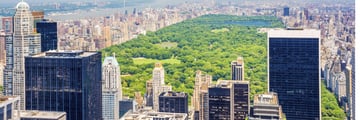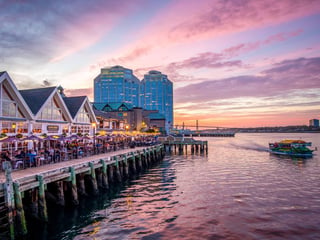Top 10 historical hotels in New York
We discover the top 10 historical hotels in New York, all famed for their illustrious guests, architectural significance and old-school charm.

#10
Hotel Edison
Where: At 228 West 47th street in Midtown Manhattan, steps from Times Square.
What: Built in the same grand Art Deco style as Radio City Music Hall, the 790-room Hotel Edison was completed in 1931; on the opening day the hotel lights were turned on by Thomas Edison by remote control from his home in Menlo Park, New Jersey. Located within walking distance to Broadway, Rockefeller Centre and Radio City Music Hall, this Midtown hotel once famously housed the ornate Art Deco Edison Ballroom, a grand dining and dancing Swing Era hotspot, and The Green Room, a bar and restaurant attracting the city’s elite. The ballroom became the 499-seat Off-Broadway Edison Theatre in 1950 (it was converted back into a ballroom in 1991) and hosted 5,959 performances of the avant-garde theatrical revue ‘Oh! Calcutta!’.
Historical highlights: The loan-shark murder scene in The Godfather was filmed in what is now Sofia's restaurant, a popular pre-show spot serving classic Italian cuisine. Most famous is the hotel’s old-fashioned Café Edison, housed in the old ballroom-cum-theatre. This Theatre District institution boasts homemade Eastern European Jewish cuisine and has become a legendary Midtown lunch spot for actors, agents, Broadway producers and playwrights. Affectionately known by regulars as the ‘Polish Tea Room’, this unique Manhattan staple serves some of the city’s best cheese blintzes, matzo ball soup and towering deli sandwiches.
More information and to book: Edison Hotel,
#9
The Roosevelt Hotel
Where: At 45 East 45th Street on Madison Avenue.
What: Opened in 1924, the ‘Grand Dame of Madison Avenue’ is an Italian Renaissance-style building that spans an entire city block. Named in honor of President Theodore Roosevelt – there is still a bronze cast of ‘Teddy’ that stands watch over the hotel’s neo-classical lobby – this society fixture allured the crème de la crème. It was once linked to Grand Central Station by way of an underground passage; white-gloved porters would greet aristocrats and socialites as they arrived by train and whisk them off to the hotel. Meticulously restored to its original Roaring Twenties grandeur in 1997 at a cost of $65-million, this lavish NYC landmark boasts 1,015 elegant guestrooms, including 33 suites, and two classic ballrooms; the Grand Ballroom with its iron-laced balconies and Tiffany chandeliers and the smaller Terrace Ballroom with an enchanting sky-mural ceiling and large arched windows draped with silk.
Historical highlights: Guy Lombardo and his orchestra performed ‘Auld Lang Syne’ over the American radio airwaves for the first time in the Roosevelt Grill, kicking off what would be a cherished New Year’s Eve tradition. The Roosevelt has appeared in several movies including Wall Street, Presumed Innocent, The French Connection and Men in Black 3 and was also one of the first hotels to offer kennels for pampered pets, child-care facilities and the luxury of a radio in every guestroom.
#8
The Carlyle
Where: At 35 East 76th Street on the northeast corner of Madison Avenue.
What: Located in New York’s Upper East Side, this swanky 188-room Art Deco style Thirties Beaux Arts landmark was named after Scottish essayist, philosopher and satirical writer Thomas Carlyle. Built as an ‘apartment hotel’ in 1930 by developer Moses Ginsberg, it lured presidents, moguls and movie stars - it was once nicknamed the ‘New York White House’ for JFK who owned an apartment in the hotel that Marilyn Monroe used to visit via a hidden tunnel. There is plenty to impress in the 35-story tower; from the gleaming black and white hued marble lobby to the guestrooms that showcase original artwork, Louis XVI–style furnishings and Art Deco touches. The dimly lit Bemelmans Bar is one the city’s most refined cocktail spots; named after children’s illustrator Ludwig Bemelmans (who created the Madeleine books) it houses a black granite bar and 24-karat gold leaf-covered ceiling.
Historical highlights: The hotel’s famed Café Carlyle hosts many first-rate cabaret stars including Woody Allen who shows up most Monday nights to play the clarinet with the Eddy Davis New Orleans Jazz Band. This intimate Manhattan supper club has remained a New York bastion of classic cabaret entertainment since the Twenties and is most synonymous with the legendary Bobby Short. Notable guests at this glamorous hideaway have included John and Jacqueline Kennedy, Princess Diana, Elizabeth Taylor, Paul Newman, Jack Nicholson, Tom Cruise and Sarah Jessica Parker.
#7
The Iroquois
Where: At 49 West 44th Street, tucked between Fifth and Sixth avenues.
What: Opened in 1900 and known as ‘the fashionable Iroquois apartment house and hotel’, this majestic Midtown Manhattan boutique hotel is housed in a French limestone mansion complete with five foot brass carriage lamps and double mahogany front doors. The décor is less American-Indian; more elegant European in this 12-story building; beyond its façade is an eye-catching lobby with an antique grandfather clock, a delightful library, nine distinctive suites and 105 individually-designed guestrooms boasting goose-down pillows, elegant furnishings and floor-to-ceiling Italian marble bathrooms. The hotel was the scene of a scandal in 1911 when Paul Geidel, previously a bell boy at the hotel, murdered a resident in his apartment. Giedel served 68 years and 245 days in prison, which was entered into the Guinness Book of World Records as the longest prison sentence ever served.
Historical highlights: The hotel’s Wigwam Bar (now know as Lantern’s Keep) opened in 1939 with a theme that paid homage to the early Pilgrims and Native Americans. The head bartender, Eddie Frank, invented two cocktails here; one was named Iroquois and the other was an imported champagne cocktail – each sold for 60 cents. The hotel was also famously home to James Dean who lived in room 803 between 1951 and 1952 when he was an aspiring actor; the hotel has a suite named after him in room 803 filled with photographs and other memorabilia.
#6
St. Regis
Where: Two East 55th Street, at Fifth Avenue.
What: Opened in 1904, this 18-story French Beaux-Arts style hotel was built by John Jacob Astor IV as a companion to the Waldorf-Astoria Hotel, of which he owned half. Named after Upper St. Regis Lake in the Adirondacks (itself named for French monk John Francis Regis who was known for his hospitality) every opulent guestroom featured central heating, air conditioning and telephones - all of which were then deemed as state-of-the-art. Nowadays this 227-room Midtown Manhattan landmark still exudes high-scale luxury; the striking lobby sets the tone with glitzy gold-leafed cornices and a grand marble staircase whilst high-ceilinged guestrooms feature crystal chandeliers, plush Egyptian-cotton-lined beds, silk wall coverings, Louis XVI antiques and Tiffany silver services.
Historical highlights: St. Regis has attracted the glitterati for decades; CBS founder William Paley and his socialite wife Barbara (known as Babe) lived at St. Regis, as did Salvador Dali. Other illustrious guests include Alfred Hitchcock, Judy Garland, Marilyn Monroe, Humphrey Bogart, Ernest Hemingway and Marlene Dietrich. The St. Regis Rooftop Ballroom overlooking Central Park once played host to jazz greats such as Count Basie, Duke Ellington and Buddy Rich, whilst the King Cole Bar with its grandiose Maxfield Parrish mural of Old King Cole is famous for inventing the Bloody Mary. First named the Red Snapper - a name considered less racy and more appropriate for distinguished guests - the vodka and tomato juice cocktail was created here in 1934 by bartender Fernand Petiot.
More information and to book: The St. Regis.
#5
Gramercy Park Hotel
Where: 2 Lexington Avenue, in the Gramercy Park neighbourhood.
What: Built in 1924, the popularity of this fashionable 18-story Renaissance Revival-style building began to wane in the Nineties following a string of tragedies connected to the former owners, the troubled Weissberg family. In 2003 it was acquired by boutique hotel guru Ian Schrager who collaborated with artist Julian Schnabel to recreate its iconic stature. The result was an elaborate East Side design hotel that opened in 2006 to much acclaim. From the black-and-white Moroccan-tiled chessboard floor in the lobby to the extravagant, eclectic and eccentric fixtures and fittings in the 185 jewel-toned guestrooms and suites, the aesthetics are dazzling throughout. In true Schrager style there is plenty of exquisite art including works from Andy Warhol, Michel Basquiat and Damien Hirst.
Historical highlights: Although Schrager sold his interests in the hotel in 2010, it is still a hotspot for the Hollywood elite and rock n’ roll royalty and serves as home to Fashion Week after-parties, celebrity book launches and music showcases. Located on the lobby level, the Rose Bar and Jade Bar are two of Manhattan’s most exclusive hotspots - as famous for their guest lists as their exotic – and expensive - cocktails. Patrons have included Oscar Wilde, James Cagney, Bob Marley, Bob Dylan, David Bowie, the Beatles, Babe Ruth and Joe Strummer. Humphrey Bogart married his first wife Broadway actress Helen Menken on the hotel’s rooftop in 1926 and the Joseph P. Kennedy family, including a young John F. Kennedy, stayed on the second floor for several months before moving to London.
#4
The Algonquin
Where: 59 West 44th Street in the Times Square/Theatre District.
What: Opened in 1902, this 181-room boutique hotel is steeped in literary history. Whilst it was the first to offer electronic door keys and also the first to welcome ladies travelling alone, it is best known as the home to Dorothy Parker's famous Round Table and the birthplace of New Yorker magazine. Most quirky is the hotel’s ritual of keeping an official hotel cat - this long-standing tradition dates back to the late 1930s when the hotel’s first general manager Frank Case welcomed a stray into The Algonquin. Male cats are known as Hamlet and female cats are called Matilda; the current resident, Matilda, is given an annual birthday party and even has her own email address. This Midtown landmark was given a multimillion-dollar face-lift in 2012; guestrooms feature ‘picture window’ headboards, silk-screened damask chandeliers and bathrooms boast glass shower stalls and Italian marble flooring.
Historical highlights: The Algonquin Round Table was a group of 20-something writers, actors and intellectuals who met daily in the hotel’s Pergola Room (later known as the Oak Room; a cabaret supper club that closed in 2012) until the group grew too large. They then moved to the Rose Room where they held court at a round table; today the so-called Round Table Restaurant is one of the most sought-after eateries for literary souls. William Faulkner drafted his Nobel Prize acceptance speech at The Algonquin, and Alan Jay Lerner and Frederick Lowe wrote ‘My Fair Lady’ in Lerner's hotel suite.
#3
The Waldorf Astoria
Where: Occupying a city block between Park and Lexington Avenues and 49th and 50th Streets.
What: This fabled Art Deco masterpiece, hailed as ‘the greatest of them all’ by Conrad Hilton, started as two hotels connected by a corridor; one was the 13-story Waldorf Hotel owned by millionaire William Waldorf Astor and opened in 1893, the other was the 17-story Astoria Hotel, erected on an adjacent site by Waldorf’s cousin, John Jacob Astor IV, in 1897. This hotel closed in 1929 and opened in its current Park Avenue location in 1931. Today The Waldorf Astoria and the exclusive Waldorf Towers (occupying floors 27 to 42) is a beacon of chic offering 1,416 guestrooms, including 303 suites.
Historical highlights: Hilton realized his lifetime dream in 1949 when he added the Waldorf Astoria to his portfolio. To date, every President since Hoover has stayed here; the hotel's guestbook reads like a who’s who of historical figures and celebrities (Frank Sinatra, Queen Elizabeth II, Elizabeth Taylor and many more). Most dramatic is the lobby, dominated by a nine foot-tall, two-ton bronze clock that was built by Goldsmiths' Company for the 1893 Columbian Exposition in Chicago, and also featuring a grand piano once owned by Cole Porter that is still played daily. The Waldorf was the first hotel to offer room service to guests and also takes credit for the esteemed Waldorf Salad, first created here by maître d'hôtel Oscar Tschirky in 1896.
#2
The New Yorker, A Wyndham Hotel
Where: 481 Eighth Avenue in Midtown Manhattan.
What: Opened in 1930 at a cost of $22.5 million, this 43-story Art Deco hotel, the New Yorker was once considered an architectural marvel. At the time it was the world’s tallest building; a one-million square-foot tower so huge that many of its staff would often get lost. It featured 2,500 guestrooms, numerous ballrooms, ten private dining salons and five restaurants employing 35 master cooks. Alluring movie stars such as Joan Crawford, Spencer Tracy and Mickey Rooney and Big Band greats such as Benny Goodman and Woody Herman, guests would enter the hotel through a private tunnel located underneath Penn Station. The New Yorker shut its doors in 1972 and became part of the Ramada chain in 2000. Whilst retaining its vintage charm, the hotel has since downsized to just 912 affordable guestrooms that offer knockout views of Manhattan’s skyline.
Historical highlights: Guests can spend the night in suite 2549, the very suite where Muhammad Ali stayed in a New Yorker Hotel Suite on the 25th floor after the legendary ‘Fight of the Century’ with Smokin' Joe Frazier in 1971. The Brooklyn Dodgers had their headquarters here for the 1941 World Series, John F. Kennedy stayed here when he was running for the presidency, and baseball legend Joe DiMaggio lived here when the Yankees were in town. Hillary Clinton used The New Yorker Hotel's ballroom as her campaign headquarters on Super Tuesday in 2008.
More information and to book: The New Worker, A Wyndham Hotel.
#1
The Plaza
Where: 768 Fifth Avenue at Central Park South.
What: One of NYC’s most iconic hotels, The Plaza opened its doors in 1907 to great fanfare; described as ‘the greatest hotel in the world’ where it was duly noted that ‘Nothing unimportant ever happens at The Plaza’. So adored by its clientele (Ernest Hemingway once advised F. Scott Fitzgerald to give his liver to Princeton and his heart to The Plaza) this stately Beaux Arts–style 19-story building originally served as a residence for wealthy New Yorkers. Once offering 805 neoclassical-style rooms, it now has 282 sumptuous guestrooms with Baccarat chandeliers, Louis XV-style beds, gold-plated fixtures and endless period pieces; there are also 152 Pied-à-Terre units that can be rented nightly when they are not occupied by their owners. This is New York luxury at its most flamboyant, especially in the Palm Court (afternoon tea is served daily at 2pm) and the gorgeous Terrace Room which has hosted many celebrity nuptials over the years including the wedding of Catherine Zeta-Jones to Michael Douglas.
Historical highlights: The Plaza is a huge part of New York’s cinematic history; it has provided the location for movies such as The Way We Were, Barefoot in the Park, Funny Girl and Alfred Hitchcock’s 1959 classic North by Northwest. Great Gatsby author F. Scott Fitzgerald regularly visited the hotel with his wife Zelda (hailed as the original flapper) and a new Great Gatsby-themed suite - The Fitzgerald Suite - has recently opened to coincide with the launch of Baz Luhrmann’s 2013 movie adaptation. Located on the hotel’s 18th floor, this dramatic 900 square-foot Art Deco space costs £1,800 per night and includes breakfast in the Palm Court.
More Inspiration
Recommended holidays















